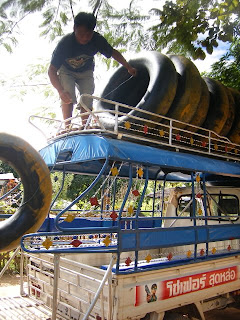Tubing down the Nam Song River is one of Vang Vieng's most popular outdoor activities, and it's also one of the very best ways to enjoy the area's gorgeous scenery. Tubers are dropped off 15km upstream from the town, and they spend the better part of the day floating down the river back to town.
The river banks are lined with bamboo bars boasting rope swings, flying foxes, or trapezes, not to mention an enticing array of fresh fruit cocktails. As tubers near a bar, the owners and staff come to the river's edge and throw out ropes to reel people in. When they've have had their fill of sunbathing and refreshments, tubers can jump back into the river and float along to the next place!
Wednesday, November 26, 2008
A Morning Walk in Vang Vieng, Laos (November 6-9, 2008)
Early morning is the best time to explore Vang Vieng's beautiful countryside and its nearby villages. Children are out fishing or bathing in the river, some are on their way to school; their parents are opening up small shops or heading out to the fields to harvest rice. A quiet mist hangs over the mountains, and the Nam Song River meanders peacefully through the awakening town.
More Photos of Vang Vieng, Laos (November 6-9, 2008)
Vang Vieng, Laos (November 6-9, 2008)
Vang Vieng is a small town in northern Laos, situated on the banks of the Nam Song River and nestled amongst towering limestone mountains covered in dense jungle. The town caters primarily to the backpacker clientele: pizza and banana pancakes feature on most menus; restaurants advertise evening showings of cult classics or "Friends" reruns on DVD; book exchanges, Internet cafes and adventure companies line the streets; and bamboo bars with hammocks and floor cushions line the river.
The beautiful scenery and relaxing atmosphere aside, outdoor pursuits are the main draw for visitors. The nearby limestone mountains are a rock climbing and spelunking paradise, and secluded green-blue lagoons overhung with vines provide a refreshing break from exploring. Tubing or kayaking down the meandering Nam Song River is an experience not to be missed, and for those more comfortable on wheels, scooters and bicycles are a great way to see the stunning countryside and outlying villages. With individual bungalows offering pristine mountain and river views - plus a porch with a hammock - for only $5 a night, it's no wonder visitors kick off their sandals and stay a while longer in this little slice of paradise.
The beautiful scenery and relaxing atmosphere aside, outdoor pursuits are the main draw for visitors. The nearby limestone mountains are a rock climbing and spelunking paradise, and secluded green-blue lagoons overhung with vines provide a refreshing break from exploring. Tubing or kayaking down the meandering Nam Song River is an experience not to be missed, and for those more comfortable on wheels, scooters and bicycles are a great way to see the stunning countryside and outlying villages. With individual bungalows offering pristine mountain and river views - plus a porch with a hammock - for only $5 a night, it's no wonder visitors kick off their sandals and stay a while longer in this little slice of paradise.
Wednesday, November 19, 2008
Final Photos (III) of Vientiane, Laos (November 4-6, 2008)
 Lao schoolgirls in the traditional uniform of long black skirt, white shirt and red or blue neckerchief
Lao schoolgirls in the traditional uniform of long black skirt, white shirt and red or blue neckerchief Buddha Park, outside of Vientiane, holds an impressive collection of very large Buddhist and Hindu sculptures. Here's the view from the top of the park's highest sculpture.
Buddha Park, outside of Vientiane, holds an impressive collection of very large Buddhist and Hindu sculptures. Here's the view from the top of the park's highest sculpture. A ground-level view of Buddha Park; the sculpture park was built in 1958 by priest-yogi-shaman Luang Pu Bunleua Sulilat
A ground-level view of Buddha Park; the sculpture park was built in 1958 by priest-yogi-shaman Luang Pu Bunleua SulilatMore Photos (II) of Vientiane, Laos (November 4-6, 2008)
Vientiane, Laos (November 4-6, 2008)
Compared to the bustling, sometimes frenetic, capitals of its neighboring countries, Laos' quiet capital of Vientiane can come as a welcome surprise. With a population of several hundred thousand people, it is the country's largest city, but it feels much more like a town than a major metropolis. The city center is easily (and quickly) covered on foot, there are no high-rise buildings to speak of, and the wide roads are often free of cars.
Despite its size, the diminutive capital has plenty to charm visitors: peaceful temples, beautiful river views and cozy restaurants. Watching the sunset over the Mekong River at one of Vientiane's many waterfront bars or cafes is a popular evening pursuit and a fitting introduction to a country that proudly proclaims its relaxed pace and laid-back attitude.
 The Presidential Palace stands at the end of a wide, tree-lined street, with its back facing the Mekong River
The Presidential Palace stands at the end of a wide, tree-lined street, with its back facing the Mekong River
 Patuxai, Vientiane's version of the Arc de Triomphe, was built in 1969 to honor those who died in the pre-revolutionary wars
Patuxai, Vientiane's version of the Arc de Triomphe, was built in 1969 to honor those who died in the pre-revolutionary wars
Despite its size, the diminutive capital has plenty to charm visitors: peaceful temples, beautiful river views and cozy restaurants. Watching the sunset over the Mekong River at one of Vientiane's many waterfront bars or cafes is a popular evening pursuit and a fitting introduction to a country that proudly proclaims its relaxed pace and laid-back attitude.
 The Presidential Palace stands at the end of a wide, tree-lined street, with its back facing the Mekong River
The Presidential Palace stands at the end of a wide, tree-lined street, with its back facing the Mekong River Patuxai, Vientiane's version of the Arc de Triomphe, was built in 1969 to honor those who died in the pre-revolutionary wars
Patuxai, Vientiane's version of the Arc de Triomphe, was built in 1969 to honor those who died in the pre-revolutionary warsOn the Road in Laos (November 3-10, 2008)
We spent several days of our two week journey driving through the Lao countryside: from the Vietnam border to Vientiane, from Vientiane to Vang Vieng, and from Vang Vieng to Luang Prabang. The scenery in Laos was lush and vibrant, a welcome change from grey and drizzly Vietnam. Bright blue skies framed technicolor green jungle, yellow rice fields and jagged limestone peaks.
Every so often, we'd pass a small village in the otherwise quiet countryside. The first sign was usually a series of fields or a group of school children biking home from school, umbrellas raised to block the sun. Soon, a cluster of stilt houses would appear, invariably surrounded by dogs and chickens. Then, more children on bikes, some more fields, and quiet countryside once again.
 Girls bike home from school, armed with colorful umbrellas
Girls bike home from school, armed with colorful umbrellas The view over the Phou Hin Boun "limestone forest"
The view over the Phou Hin Boun "limestone forest"
Every so often, we'd pass a small village in the otherwise quiet countryside. The first sign was usually a series of fields or a group of school children biking home from school, umbrellas raised to block the sun. Soon, a cluster of stilt houses would appear, invariably surrounded by dogs and chickens. Then, more children on bikes, some more fields, and quiet countryside once again.
 Girls bike home from school, armed with colorful umbrellas
Girls bike home from school, armed with colorful umbrellas The view over the Phou Hin Boun "limestone forest"
The view over the Phou Hin Boun "limestone forest"


















































